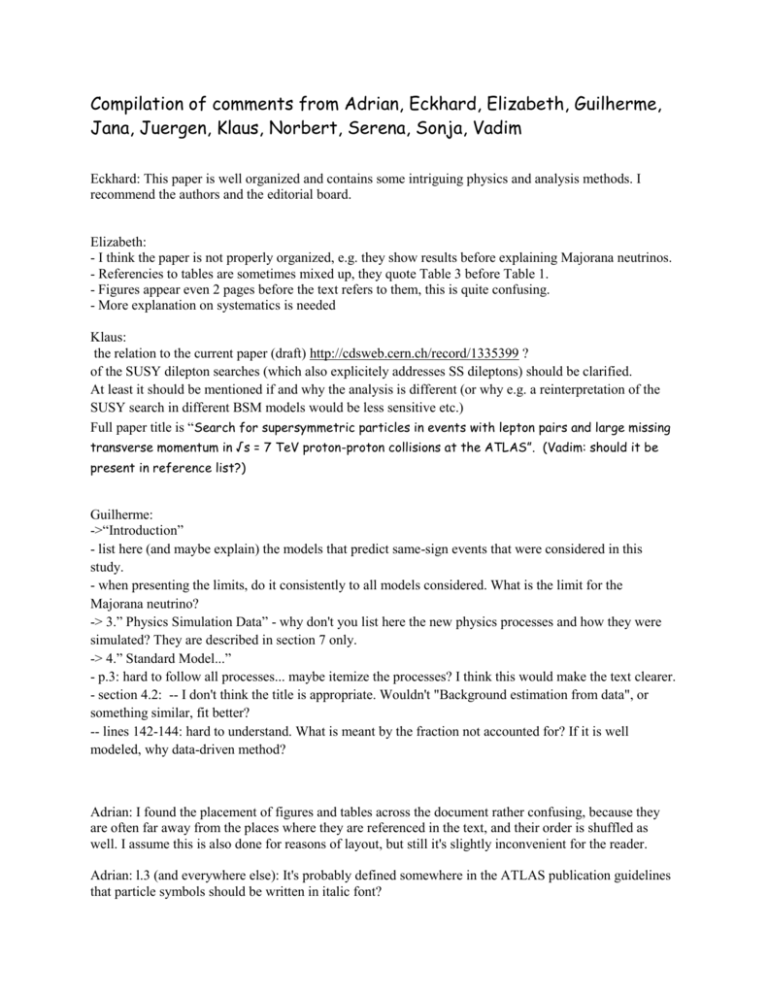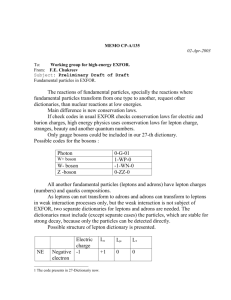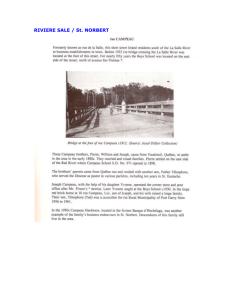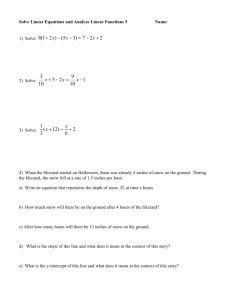DileptonComments - Indico
advertisement

Compilation of comments from Adrian, Eckhard, Elizabeth, Guilherme, Jana, Juergen, Klaus, Norbert, Serena, Sonja, Vadim Eckhard: This paper is well organized and contains some intriguing physics and analysis methods. I recommend the authors and the editorial board. Elizabeth: - I think the paper is not properly organized, e.g. they show results before explaining Majorana neutrinos. - Referencies to tables are sometimes mixed up, they quote Table 3 before Table 1. - Figures appear even 2 pages before the text refers to them, this is quite confusing. - More explanation on systematics is needed Klaus: the relation to the current paper (draft) http://cdsweb.cern.ch/record/1335399 ? of the SUSY dilepton searches (which also explicitely addresses SS dileptons) should be clarified. At least it should be mentioned if and why the analysis is different (or why e.g. a reinterpretation of the SUSY search in different BSM models would be less sensitive etc.) Full paper title is “Search for supersymmetric particles in events with lepton pairs and large missing transverse momentum in √s = 7 TeV proton-proton collisions at the ATLAS”. (Vadim: should it be present in reference list?) Guilherme: ->“Introduction” - list here (and maybe explain) the models that predict same-sign events that were considered in this study. - when presenting the limits, do it consistently to all models considered. What is the limit for the Majorana neutrino? -> 3.” Physics Simulation Data” - why don't you list here the new physics processes and how they were simulated? They are described in section 7 only. -> 4.” Standard Model...” - p.3: hard to follow all processes... maybe itemize the processes? I think this would make the text clearer. - section 4.2: -- I don't think the title is appropriate. Wouldn't "Background estimation from data", or something similar, fit better? -- lines 142-144: hard to understand. What is meant by the fraction not accounted for? If it is well modeled, why data-driven method? Adrian: I found the placement of figures and tables across the document rather confusing, because they are often far away from the places where they are referenced in the text, and their order is shuffled as well. I assume this is also done for reasons of layout, but still it's slightly inconvenient for the reader. Adrian: l.3 (and everywhere else): It's probably defined somewhere in the ATLAS publication guidelines that particle symbols should be written in italic font? Vadim ll.204,223 Usually quarks and neutrinos even heavy are not called "resonances". Vadim ll12,218-219 Majorana neutrinos are described by corresponding lagrangian with motion part and not at all by effective operators only. Elizabeth: Figure7 and Figure 12 used different markers for the "observed" events Material ordering Sonja ll.76–79: lepton trigger selection ought to be moved to the beginning of section 4 Norbert Section 7: first there is an introduction paragraph which however has specific plots already and quoted KS-distances, but then there are sections 7.1 and 7.2 following on the same subject. No references are given for these models. (Vadim: move everything about KS-distance and SM p-value to corresponding 7.X subsections. And add definitions of these) Vadim Sect 6,7: Main result of Sec.6 the “model independent” limits in Tab.4 is based on model efficiencies (Tab.5) explained in Sec.7 . I propose to move Sec.6 behind Sec.7. Vadim Sec.6 Setting “model independent” limits based on efficiency estimations at fixed masses for several very specific models seems not very justified. Chapter 4.2 “Standard Model Background Sources” – seems very badly written Juergen: My main comment is that the description of both the background sources and the way their contributions are estimated needs to be improved. I have read Section 4.2 several times now and I still don't understand what they are doing. The confusion starts for me with their definition of the "fake" leptons (but doesn't end there). Jana p.5,6 ll.136-175: This chapter I found a little hard to read/understand. Maybe it would be helpful to add 1 or 2 formulas (e.g. for th misid rate of the background, final background calculation) Eckhard: The term fake is used very loosely. It should be mentioned that the term, in this paper, also refers to non-isolated leptons. Eckhard: Are exactly two leptons required? If yes, what quality criteria are applied? If not, how do you deal with combinatorics? Eckhard: The background consisting of one good-isolated lepton and a "fake" is not much discussed. I have two questions regarding this background: In a W+jet event with W-> l nu and an additional lepton from QCD. Is this included in the figures as a fake background? If yes this should be stated explicitly in the text. Another example: Z --> mu mu plus another muon from QCD. One muon from the Z and one from QCD are reconstructed. Is this also counted as fake? Adrian l.93: I found the description of fake leptons confusing. The term "leptons from jets" seems to imply that those particles are in fact leptons, but concealed within a jet. On the other hand, the term "fake" implies that they are not really leptons, but some mis-identified other particles. I assume the truth is that you simply cannot tell the difference because the truth is unknown, but is there still a way to avoid this difficulty in naming? (But probably everybody except myself knows what's going on, anyway.) Adrian ll.152-155: I don't get that, but this may be related to my difficulty in understanding what a fake lepton is. Vadim p.5: In the list of electron fakes the jets are not included although they are mentioned later ln.137 Adrian l.197: Before, lines 93 and 94 seemed to imply that there are only fake and prompt leptons. Line 197 and also the caption to table 3 indicate that there are also other kinds of leptons, so non-prompt does not automatically mean fake. Norbert: Figure 1 and text lines 152 – 155: \epsilon_fake should NOT be called fake rate, it is a fake probability or a susceptibility for fake electrons. I would even not use the word “efficiency” for detecting something unwanted (fakes). A rate definitively is something per time. Norbert l.152-155: I don’t think that these 4 lines understandably explain how \epsilon_fake is measured. It should be explained more clearly. Serena Chap. 4.1: I think some of the experimental details have been dropped. For example, the calibration of the objects is not explicitely mentioned. This is probably ok for leptons (the two references on Electons and Muons at line 117 and 126 should contain already this information), but for jets there is not such information. As this was mentioned in other papers, it is probably worth to mention it here, or at least put a reference to it. (This is quite well explained in the backup note, but that is not public!) Serena l.128-135: it looks like no jet cleaning is applied (I have also looked at the backup note and could not find any reference to it). In other ATLAS papers, the "rejection of non-collision backgrounds" (i.e. the jet cleaning) was explicitely mentioned. Was the cleaning made or, if not, would be possible to confirm that the contribution from non-collision backgrounds had been studied and estimated as negligible, and add a clear statement on that? ======= Serena Tab. 3: two channels (ee and em) show quite a disagreement between data and MC. any comment on that (maybe in the section on background estimates, as probably this is what matters most in this step)? It is not very easy to interpret those numbers, just looking at the table, as the difference is quite visible.... and the same difference is visible also in the plots in figure 5. Adrian Tab.3 last line: Anything to mention about the rather strong discrepancy between observation and prediction? ======= Adrian l.215: What is an "ensemble of simulated experiments"? Something similar appears in line 290. Sonja ll.147-155: Was the choice of variables (pT, HT) used for parameterisation optimised? ======== Norbert l.168: \epsilon_fake is fit by a Baysian neural network to extract a smooth functional dependence.” Why ANN fit ? Norbert ll.168 –172: Again a not very transparent explanation of what is done: I do not understand it. Adrian l.168: Why is this fancy method not applied to the electron plot? Vadim fig.2 If H_t=Sum P_t, then why the right bottom corner with P_t>H_t is populated? Fig.1 is correct however. ======== Adrian Appendix: Are those event display useful? They show particles in ATLAS, but is there something particular to see? Figures 16 to 18 are referenced nowhere. Shouldn't they be mentioned in the mail text of section 7? Text comments: Serena l.4: I am not an english native speaker, but I found the first sentence quite weird. Something like "We present an inclusive search..." or "An inclusive search for new physics, in events... charge, is presented." sounds better to my ear (I prefer the first proposal). Guilherme l.8: compared to -> compared with Guilherme l.10: fiducual-> fiducial Elizabeth l.54: definition of W_R is missing here Norbert l.60: “by a combination of” -> use the label inner detector containing … Sonja l.70: “Trigger signals...”: from here until l. 74 it may be unclear whether the text is still referring to the muon system or not. Adrian l.73: measuring \eta, not only its absolute value Norbert l.89: what is “near-next-to-next-to-leading order”? ==== Norbert Fig.1: appears two pages ahead of its reference in the text Adrian Fig.1: The caption should maybe include the word "electron" in the text. Is $H_T$ the usual symbol for a common variable? I've never heard about it, and I only found the explanation two pages later in the main text. ==== Norbert l.97: “electron trident“ give explanation of this after a double dot like electron trident: an opposite-sign lepton pair can be mistaken for same-sign if an electron undergoes … Eckhard l.98: It seems to me that the term electron trident refers to a pair of opposite sign ISOLATED leptons. I suggest to write "opposite sign ISOLATED lepton pair" in line 98. Jana l.100: To "of the opposite charge" I would add: "of the opposite charge with respect to the primary one". ==== Norbert l.103: Misidentification of muon charge is negligible due to near absence of bremsstrahlung off muons. Jana l.108 "To select leptons" replace by "To select lepton pairs". Adrian l.118: If they are excluded in the crack, should the word "reliably" (for the entire interval) maybe be dropped? At the moment the statement looks a bit inconsistent. Adrian, Jana l.131: Add the index "jet" to E_T (see line below) Adrian l.145: Is the term "reflection peak" a commonly-known one? Norbert l.157: what does purified mean in this context Norbert l.159: relative selection efficiency -> relative selection probability Norbert Fig.2: it appears two pages ahead of reference to it. fake rate -> fake probability =========== Norbert ll.161–165: again the text is understandable but not very clear “classified into components by the inclusion or non-inclusion” -> “events are classified into classes depending on whether each electron is also found by the tight selection” Sonja l.161: unclear l.162: “Events are classified into components...” ==> “Fractions of events with zero, one or two electrons from the tight sample were determined”. Adrian l.162-164: Use "categories" or "subsets" instead of "components"? A single entity (e. g. background) is broken down into components, but separate items (e.g.events) are classified into categories, I think. =========== Elizabeth l.166: one more sentence with details on the transformation will be helpful Jana l.169: replace "loosely selected muon candidate selection" with "loose muon candidate selection" Adrian l.171-172: Does that, in other words, simply mean that the loose and tight selection results are almost the same? Elizabeth l.174: here is not clear to me how they do it for the combined channel, do they use the neural network in this case? Norbert l.177: drop “important” Norbert l.178: “with component categories indicated” … Where do I see in figure 3 the component categories? Sonja l.183: Table 3 is mentioned in the text before Tables 1 and 2. Eckhard l.183: Table 3 is mentioned before table 2 and table 1 is not mentioned at all in the text. Norbert l. 195: Beyond the peak … refer to figure 2 (a) here ========== Norbert Tab.3,4: it is very unusual to write the statistical and systematic errors as upper and lower scripts, as there is enough space I suggest to do it the usual xx ± stat ± sys way. Norbert Tab.4: explain what exactly “fiducial” means here Guilherme Tab.3,4: The signs in the uncertainties are wrong. Should be only "+" or "-" and not "+-". (these are stat. and syst. errors – strange author logic…) Vadim Tab.4 caption is misleading. It gives an impression of giving the measured cross section of the expected background sources. Instead it gives "model independent" limits on "resonance production" based on "lowest efficiencies" of 4 specific models. ========== Sonja l.184: Isn't the point that epsilon_fake in the data sample used to determine this background may differ from the one in the signal region? Current wording sounds as if it were better to use MC. Sonja Table 1 caption, last line: “or electron...” ==> “or of electron...” Jana l.197: "are predicted" --> "are predicted by the Standard Model" Norbert l.218 ff: here heavy majorana neutrinos and LRS theories are introduced without reference (V. Authors give references in introduction only. References should be added consistently throughout chapter 7) ======== Norbert Fig. 6: reverse rows either in Figure or in caption ??? Jana p.11 Fig.6 caption: "For dilepton invariant mass " --> "For the dilepton invariant mass distribution" ======== Eckhard Fig.8 caption: "The topology may ALSO be found in other ..." Adrian Fig.8: Could the lower right branch of the diagram (chargino decay) be flipped to make it a bit more symmetric and easier to recognise? Elizabeth l.233 onwards: this has to be moved to a better place, here is too late Adrian l.263,269: The chargino looks a bit distorted in LaTeX, probably due to a right brace. It looks normal in other places. Jana l.261 formula 7.1 For the second chi the index 1 is missing. l.265 "due to the leptonic BF" --> "due to the higher leptonic BF. Norbert Fig.9: Why m_gluino = 510 GeV, why not 500? Why are there corners in the diagonal line? Jana p.14 figure 10: The index of the mass of the m_chi_chi is deplaced. Adrian l.275 and Fig.9: It's not clear to me how the gluino mass enters this plot, but that's probably due to my own lack of SUSY knowledge. Jana Fig.11: it is not referenced in the text. This should be added to the text. figure 12, "of mass" -->"of its mass" Jana l.301 "in analysis" --> "in the analysis" Adrian l.282: Does "the inclusive sample" refer to all same-sign dilepton events? Adrian l.345: The "et al." got damaged somehow







